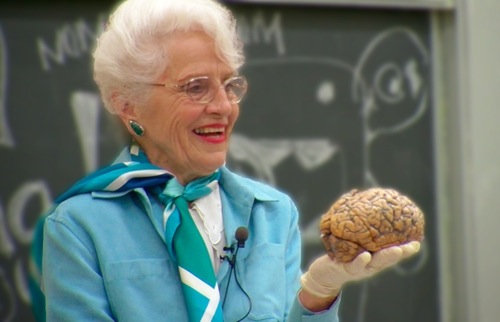
Marian Diamond keeps her brain in a hatbox—not her own brain, but the preserved human brain she shows in her famously popular anatomy lectures at the University of California, Berkeley. Holding the brain gently in her gloved hands, Professor Diamond introduces her students (including 1.5 million YouTube viewers) to this cell mass that weighs only three pounds yet “can conceive of a universe a billion light years across.”
Diamond has been leading hands-on encounters with the brain, as a scientist and a mother, since her own children were in elementary school and she brought brains from her lab to share with the whole class. “Students want to know if the brain can change as it ages,” Diamond says. You bet it can. Diamond’s renowned research at Berkeley has found that with enrichment, the brain can continue to grow even in later life.
The American Association of University Women, a howtosmile.org national partner, named Diamond the Distinguished Senior Woman Scholar in America. As a UC professor and as past director of the Lawrence Hall of Science, she has championed hands-on science education in nearby neighborhood schools, across the nation, and around the world. Diamond sees the hands as metaphors for how the brain learns. “I consider the hands as two big nerve cells,” she explains. “The palm is the nerve cell body, the fingers are dendrites that pick up the stimulus, and the arm is the axon that transmits the information.”
Wherever she meets curious young students, Diamond uses hands-on materials to illustrate neuroscience and other aspects of anatomy. In a remote village in Cambodia, it wasn’t preserved brains at her fingertips, but fresh beef hearts and lungs provided by the cook from Diamond’s hotel. Diamond can enlist even the simplest objects, like bean bags (that she sewed), to engage kids anywhere in informal lessons that teach hand-eye coordination, or the force of gravity, or just plain FUN.
“In any language, having fun is extremely important to learning and brain development,” she observes. Physical activity is equally important because “the body needs the brain and the brain needs the body.”
Diamond follows her own teaching at age 84, simultaneously keeping her body and brain fit by playing ping-pong with lots of laughter tossed into the game. “After all,” she explains, with a brilliant and knowing smile, “laughing increases circulation to the brain!”
Every activity at howtosmile.org exercises the brain. For some that specifically teach about brain function, try
—The Domino Effect: Model a Nerve Cell’s Signal Transmission or
And don’t forget to laugh!
Photo © Luna Productions (http://www.lunaproductions.com)


* You can follow any responses to this entry through the RSS 2.0 feed.